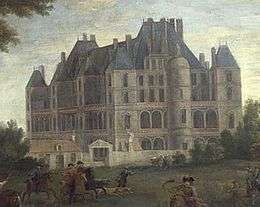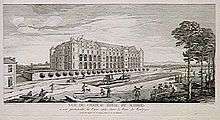Château de Madrid
The Château de Madrid was a Renaissance building in France. It was built in Neuilly, on the edge of the Bois de Boulogne, near Paris in the early 16th century. It fell into disuse in the 17th and 18th centuries and was almost completely demolished in the 1790s.

History

The construction of the château was ordered by Francis I of France in 1527, who had been captured at the Battle of Pavia in 1525 and held for some months in Madrid. On his return to France in 1526, Francis found the Louvre uncomfortable, and he desired a new palace.
Initially called the Château de Boulogne, the new building quickly became known as the Château de Madrid, taking its name from the Royal Alcázar of Madrid, the royal castle in Madrid. Both buildings were constructed on the edge of a forest near a large city, and both were made up of a long central corps de logis with loggias on two storeys and a cubical pavilion at each end.
The construction work was at first directed by Florentine Girolamo della Robbia and later by French architects. The building was completed during the reign of Henry II of France, about 1552.
_-_Madrid_front_facade.jpg)
The Château de Madrid was richly decorated inside and out. Almost all of the exterior walls were covered in majolica and high relief; as a result it was also nicknamed the "Château de Faïence", the latter word describing earthenware decorated with colorful opaque glazes. Its architecture bore clear influences from both Renaissance Italy, in that its building plan resembled the letter H and that its exterior was richly ornamented, and France, because of the towers on each corner of both pavilions and its internal layout, based on the Châteaux of Chenonceau and Chambord. This form that was repeated again at La Muette and Challeau.
During the Regency of Louis XV of France, Marie Louise Élisabeth d'Orléans, (the daughter of the Regent) lived at the castle. The château was abandoned by the House of Bourbon after her death. In 1787, an arrêt du Conseil of Louis XVI of France ordered it to be sold with a view to demolition, together with the Château de la Muette, the Château de Vincennes and the Château de Blois.
The building was in ruins before the French Revolution, after which it was bought on 27 March 1792 by M. Leroy, a demolition contractor, who paid with assignat banknotes issued by the Revolutionary government. Few traces have survived: one stone capital and three faience fragments are held by the museums of Sèvres and Écouen. The site has been built upon subsequently and the foundations destroyed.
References
Further reading
- Monique Châtenet, Le château de Madrid au bois de Boulogne, Paris, Éditions Picard, Collection De Architectura, 1987 – ISBN 2-7084-0336-2 (in French)
- Alberto Faliva, Giuseppe Dattaro et le petit palais de Marmirolo, Francesco Dattaro et le château de Madrid : étude des relations Franco-italiennes autour de 1530-1550., dissertation CESR Tours, 2004
- Alberto Faliva, Francesco e Giuseppe Dattaro. La palazzina del Bosco e altre opere, Cremona, 2003
- Alberto Faliva, Alain Erlande-Brandenburg, Robert J. Knecht, Richard Ingersoll, Aurora Scotti Tosini, David Ekserdjian, Renaissance Franco-Italienne. Serlio, Du Cerceau et les Dattaro, Cremona, 2005
- Alberto Faliva, Sebastiano Serlio e l'Ordine Composito dei Romani Antichi, Bollettino Ingegneri, Firenze, numero 12, 2006
- Alberto Faliva, Jacopo Sansovino e altri dodici casi. Un altro medioevo (questa volta rinascimentale), Bollettino Ingegneri, Firenze, numero 11, 2007
External links
| Wikimedia Commons has media related to Château de Madrid. |
- Le château de Madrid (in French)
- Le château de Madrid au bois de Boulogne (in French)